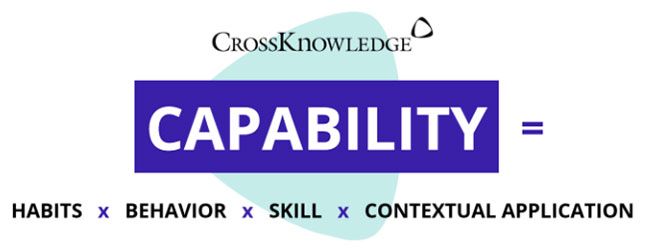We hear it all the time: companies want to prepare their people to be “future-proof.” But what does that really mean?
Some focus on mastering a single skill or the latest technology. Others hope their teams can just keep up with change. The truth is, being future-proof isn’t about chasing trends—it’s about building real capability that drives tangible business results.
At CrossKnowledge, we help organizations move beyond one-off training and short-term skill fixes. Our Capability Equation shows how combining habits, behaviors, skills, and contextual application creates a workforce that adapts, performs under pressure, and delivers measurable results.
In this article, we’ll explore why capability building matters more than skills, what it looks like in practice, and how leading organizations turn learning into lasting impact.
What does it mean to be future-proof?
A truly future-proof workforce doesn’t just know things, they do things effectively. They solve problems under pressure, make smart decisions in real-world situations, and contribute to lasting business transformation.
Being future-ready means having people who:
- Keep learning and respond quickly to new opportunities or challenges
- Understand your organization’s goals, vision, and culture
- Bring capabilities, not just skills, a mix of knowledge, behaviors, mindsets, and readiness that lead to real impact
- Stay resilient during disruption, supported by learning that fits naturally into daily work and is powered by the right technology and workforce insights
According to the World Economic Forum’s Future of Jobs Report 2023, 44% of core skills will change by 2028. Organizations that don’t develop their people risk falling behind in their ability to innovate, adapt, and stay relevant. It’s, “How do we rethink what L&D is here to do?”
Why capability matters more than skills
Many learning programs focus on teaching a specific skill. But skills alone aren’t enough.
Capability building ensures people can consistently apply what they know, make good decisions under pressure, and deliver measurable results.
| Skill | Capability |
| Task-specific knowledge or technique | The ability to act with judgment, in context |
| Taught and tested in isolation | Demonstrated over time and in context |
| Can quickly become outdated | Adapts and grows with experience |
| Measured by completion or certification | Measured by behavior change and business results |
For example, a manager might learn the theory of giving feedback—that’s skill. But when they handle a tough conversation with empathy, clarity, and confidence, aligned with company values, that’s capability in action. Organizations that prioritize capability see faster revenue growth, higher engagement, and stronger retention (OECD 2024; McKinsey 2023).
How to build a future-proof workforce
Building a future-proof workforce isn’t about launching the latest trending course. It’s about capability building, i.e., helping people apply knowledge, work effectively across teams, think critically, and take initiative, even without step-by-step instructions.
Being future-ready means enabling employees to act decisively when it matters most: under pressure, in real work situations, and when stakes are high. That’s why organizations focused on capability development look beyond skills to behaviors, habits, and context.
At CrossKnowledge, we break capability down into four interconnected elements:

- Habits: daily routines that shape consistent performance
- Behaviors: observable actions that create impact
- Skills: knowledge and techniques people have mastered
- Contextual application: doing the right thing at the right time
Unlike isolated skill development, capability building ensures learning transfers to the workplace. Employees not only know what to do, they can consistently do it, even in challenging or unpredictable situations.
How leading organizations build capability
You don’t need to guess the future. You need to prepare your teams with a strategy that’s practical, flexible, and aligned with business goals. Leading organizations focus on five key actions:
Align from the start
Learning teams and business leaders define what success looks like and set a clear direction.
Shift the focus
Instead of asking what people need to know, they ask what people need to be able to do, and how to support them.
Use the Capability Equation:
Identify habits, behaviors, skills, and real-world applications that drive lasting results.
Design for transfer
Learning includes practice, feedback, reflection, and ongoing support, not just one-off courses.
Enable managers
Managers reinforce habits, remove obstacles, and coach teams on the job.
Finally, they measure readiness by behavior change, not course completions. Success looks like improved decision-making, stronger collaboration, and greater initiative, all measurable outcomes that show capability building is driving real business impact.
One final thought
Capability building doesn’t happen by launching a program. It grows through intentional strategy, collaboration, and commitment. The CrossKnowledge Capability Equation provides the formula—but it’s the people, processes, and culture that bring it to life.
Before your next learning initiative, ask yourself: Are we just delivering training, or are we enabling real performance? In a world full of uncertainty, capability sets your workforce apart. You don’t need to predict every challenge. You need people who can adapt, act, and thrive, no matter what comes next.
The shift from skills to capabilities is already underway.
Watch the first session of our Future-proof workforce series and see what it means in practice.